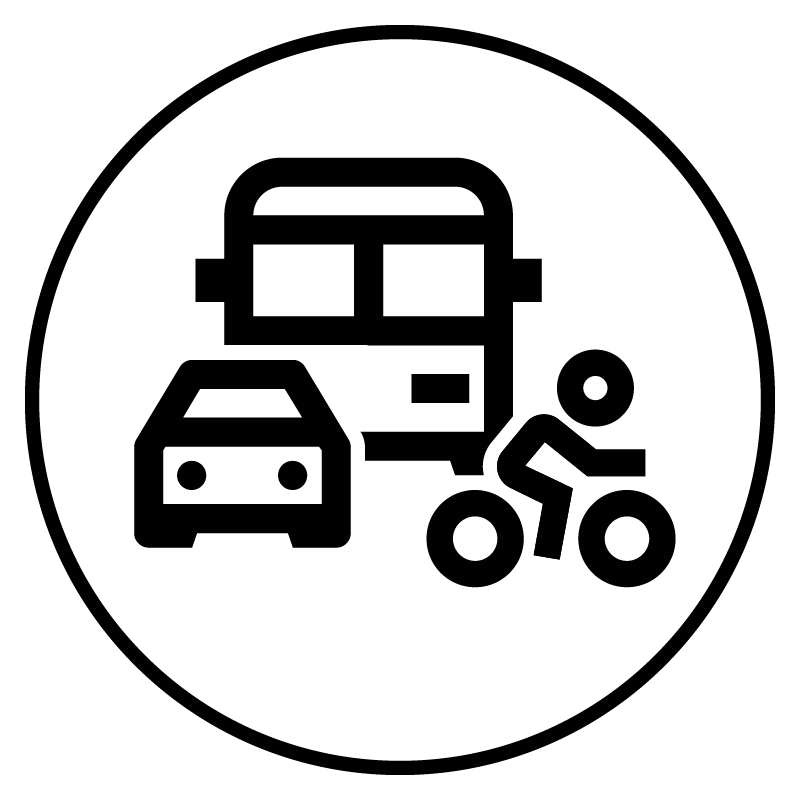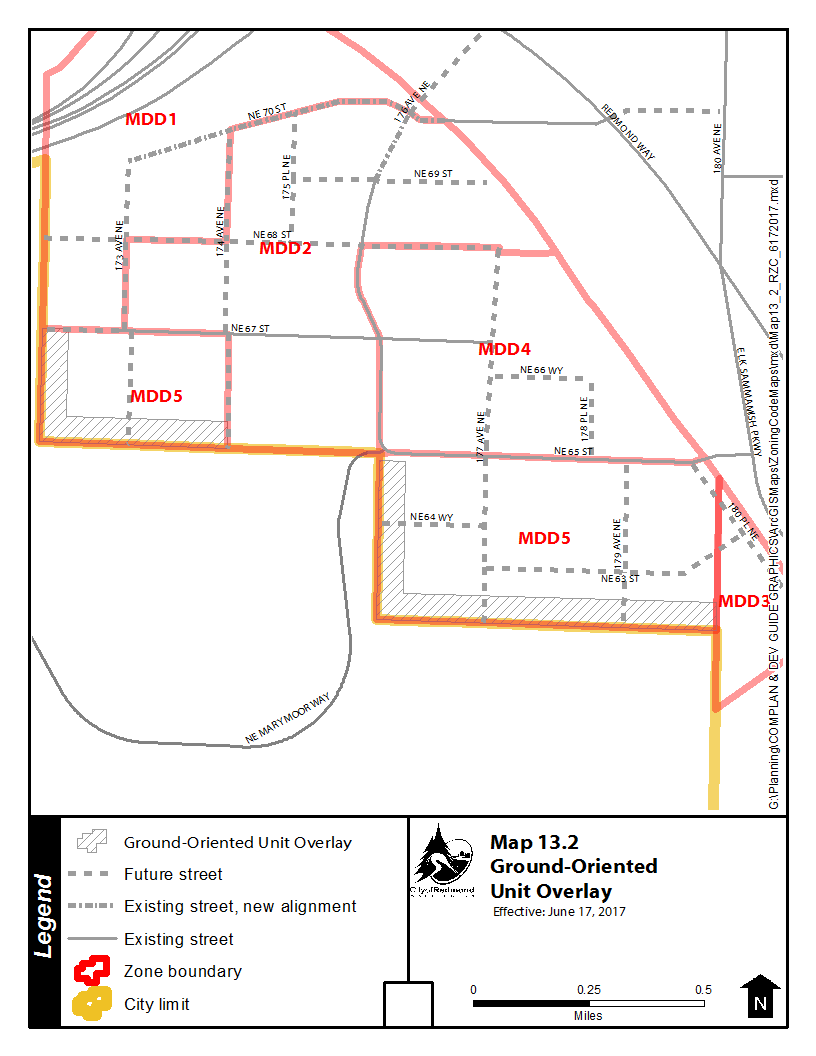21.13.110 MDD5.
A. Purpose. The purpose of the MDD5 zone is to provide opportunities for community gathering, multifamily living and locally oriented goods and services, enhanced by proximity to Marymoor Park, while supporting existing buildings and uses. Over time, as buildings reach the end of their useful economic lives or property owners decide to redevelop, a transition will occur, consistent with the vision for the Marymoor Subarea.
The following table is specific to this zone and provides references for each of the major topics that are regulated throughout the code. The individual topics provide function as connection or linkage to the chapters and sections of the Redmond Zoning Code that apply to development within this zone.
Land and Structure
|
| Environment
| Community
| Process
| Money
| Incentives
| Other
| |
|---|---|---|---|---|---|---|---|---|
B. Maximum Development Yield.
|
Table 21.13.110A |
|||
|---|---|---|---|
|
Minimum |
Bonuses Available |
Maximum |
|
|
FAR |
Refer to RZC 21.13.150, MDD Floor Area, for floor area ratios. |
||
|
Height |
3 stories |
3 stories |
5 stories |
|
Refer to RZC 21.13.140, MDD Building Placement and Form, for building placement and form. |
|||
C. General Allowed Uses and Cross-References. The following tables provide references for each of the allowed use classes for the zone. References are provided for assistance in associating the current use classes with the use classes and associated definitions that were in effect prior to December 31, 2021. Additional references assist in generally aligning use classes with the Redmond Building Code, Institute of Transportation Engineers (ITE) Trip Generation Manual, and the City’s business licensing system. Additional information specific to the intended use may be necessary.
Uses that are not listed below nor within the associated definition of the individual use category or class shall be classified by the Code Administrator for applicability based on the purpose and intent of the zone within which the use is proposed.
Residential Use Category | Residential Use Class | Former Use Classification (Prior to Dec. 31, 2021) | Use Permissions | Building Code Occupancy Class | ITE Trip Generation Manual Land Use Code |
|---|---|---|---|---|---|
P | R | 200 – 299 | |||
P | R | 200 – 299 | |||
P | R | 200 – 299 | |||
P | R | 200 – 299 | |||
P | R | 200 – 299 | |||
Mixed-use residential | Mixed-use residential | P | R | 200 – 299 | |
P | I | 600 – 699 |
Nonresidential Use Class | Former Use Classification (Prior to Dec. 31, 2021) | Use Permissions | Building Code Occupancy Class | ITE Trip Generation Manual Land Use Code |
|---|---|---|---|---|
L | M | 800 – 899 | ||
1. Gasoline service; 2. Outdoor automobile sales, rental, or service are prohibited. Indoor and outdoor sales, rental, and service of non-motorized vehicles such as bicycles are permitted. | N | |||
L | B | 700 – 799, 900 – 999, 600 – 699 for veterinary | ||
L | A | 900 – 999 | ||
Pet and animal sales and service | L | B | 800 – 899 | |
P | M, F, H | 100 – 199 | ||
Artisanal manufacturing, retail sales, and service | P | M, F, H | 100 – 199 | |
P | ||||
L | ||||
1. Auto impoundment yards and other outdoor storage. | N | |||
L | ||||
L | ||||
P | ||||
L, C | ||||
L, C | ||||
Wireless communication facilities | Wireless communication facilities | P | ||
Arts, entertainment and recreation | L | A | 400 – 499, 500 – 599 | |
Arts, entertainment and recreation | L | 400 – 499 | ||
Education, public administration, health care and other institutions, except those listed below | P | E | 500 – 599 | |
Education, public administration, health care and other institutions, except those listed below | P | B | 700 – 799 | |
Education, public administration, health care and other institutions, except those listed below | P | I | 600 – 699, 700 – 799 | |
Faith-based and funerary | Education, public administration, health care and other institutions, except those listed below | L | A, B, H, I, R, S | 500 – 599 |
1. Crematorium. | N | |||
L | E | 500 – 599 | ||
P |
D. Allowed Uses and Basic Development Standards. The following table contains the basic zoning regulations that apply to uses in MDD5. To use the chart, first read down the left-hand column titled “Use.” When you have located the use that interests you, read across to find regulations that apply to that use. Uses are permitted unless otherwise specified in the Special Regulations column. Permitted uses may require land use permit approval. See RZC 21.76.020, Overview of the Development Process, for more information. The following headings are used in the table:
1. § = Section number
2. Use = Land use
3. Parking Ratio = Parking ratio for the use
4. Special Regulations = Special regulations that apply to the use
|
Table 21.13.110B Allowed Uses and Basic Development Standards |
|||
|---|---|---|---|
|
§ |
Use |
Parking Ratio: |
Special Regulations |
|
Residential1 |
|||
|
1 |
Unit (2, 2) |
A. Ground-oriented units only. Permitted only in Ground-Oriented Unit Overlay Area. See Map 13.2, Ground-Oriented Unit Overlay. B. Minimum density: 12 dwelling units per gross acre. |
|
|
2 |
|||
|
3 |
|||
|
4 |
Ground-oriented units: Unit (2, 2) All other structure types: Unit (1, 1.5) plus 1 guest space per 4 units for projects of 6 units or more |
Ground floor: Only ground-oriented units allowed in Ground-Oriented Unit Overlay Area. |
|
|
5 |
Bed (0.5, 0.1) |
Ground floor: Ground-oriented units only in Ground-Oriented Unit Overlay Area. |
|
|
6 |
Unit (1, 1.5) plus 1 guest space per 4 units for projects of 6 units or more |
Prohibited in Ground-Oriented Unit Overlay Area. |
|
|
7 |
See Special Regulations |
A. Ground floor: Ground-oriented units only in Ground-Oriented Unit Overlay Area. B. Parking requirements are as follows: 1. Multifamily housing for senior citizens: Unit (0.5, 1); 2. Nursing home or long-term care facility: Four patient beds (1, 1); 3. Retirement residence with no skilled nursing facility: Unit (1, 1); 4. Retirement residence with skilled nursing facility: Worker on largest shift (1.25, 1.25). C. A traffic mitigation plan is required. The plan shall address traffic control, parking management (including mitigation of overflow parking into adjoining residential areas), and traffic movement to the arterial street system. |
|
|
8 |
1,000 sq. ft. gfa (2, 3) |
A. Limited to less than 75,000 square feet gross floor area in a single use. B. Parking standards for restaurant uses: 1,000 sq. ft. gfa (9, 10). C. Mini-warehouses/self-storage shall only have retail or customer service functions facing the building front on the ground floor; all storage units and other functions shall be located on other block faces or on the second level or higher of the building front block face. |
|
|
Pet and animal sales and service |
|||
|
Hotel, motel, and other accommodation services |
|||
|
9 |
1,000 sq. ft. gfa (2, 3) |
Uses in new structures permitted after June 17, 2017, shall not be materially detrimental in terms of noise, truck traffic and other potential operational impacts with nearby multistory mixed-use/residential developments. |
|
|
10 |
Artisanal manufacturing, retail sales, and service |
1,000 sq. ft. gfa (2, 3) |
|
|
Transportation, Communications, Information and Utilities |
|||
|
11 |
1,000 sq. ft. gfa (2, 3) |
||
|
12 |
Uses in new structures permitted after June 17, 2017, shall not be materially detrimental in terms of noise, truck traffic and other potential operational impacts with nearby multistory mixed-use/residential developments. |
||
|
13 |
Adequate to accommodate peak use |
Shall not be located on a parcel that abuts a residential zone, RZC 21.04.030, Comprehensive Allowed Uses Chart. |
|
|
14 |
Shall not be located on a parcel that abuts a residential zone. |
||
|
15 |
1,000 sq. ft. gfa (2, 3) |
||
|
16 |
Wireless communication facilities |
See RZC Chapter 21.56, Wireless Communication Facilities, for specific development requirements. |
|
|
17 |
Adequate to accommodate peak use |
Requires a conditional use permit if 40 feet in height or greater. See RZC 21.76.070.K, Conditional Use Permit. |
|
|
18 |
|||
|
Arts, Entertainment and Recreation |
|||
|
19 |
Adequate to accommodate peak use |
A. Parking requirement for natural or other recreational parks: 1,000 sq. ft. gfa (0, Adequate to accommodate peak use). |
|
|
Education, Public Administration, Health Care and Other Institutions |
|||
|
20 |
Adequate to accommodate peak use |
A. Provisions for day care centers: 1. Parking requirement: Employee on maximum shift (1, 1); 2. Play equipment shall be located no less than ten feet from any property line; 3. Shall not be located closer than 300 feet from existing day care operation in residential zone. |
|
|
21 |
Faith-based and funerary |
Assembly uses: 1,000 sq. ft. gfa (10, 10), or number of fixed seats (0.2, 0.2) |
A. Decorative fencing or decorative walls and landscaping on side or back lots are required when necessary to prevent visual impacts on neighboring properties and public shoreline areas. B. Refer to RZC 21.08.280, Faith-Based and Funerary, for requirements concerning faith-based and funerary uses. |
|
22 |
1,000 sq. ft. gfa (2, 3) |
Uses in new structures permitted after June 17, 2017, shall not be materially detrimental in terms of noise, truck traffic and other potential operational impacts with nearby multistory mixed-use/residential developments. |
|
|
Other |
|||
|
23 |
A. Shall not locate in required parking, landscaping, or drive aisle area, or any area that would impede emergency access. B. Shall not reduce or interfere with functional use of walkway or plaza to below standards of Americans with Disabilities Act. C. Structures shall be secured to prevent tipping and endangering public safety. D. Maximum size is six feet wide by ten feet long. E. Administrative design review required for structures. |
||
|
24 |
|||
|
25 |
A. Shall not locate in required parking, landscaping, or drive aisle area, or any area that would impede emergency access. B. Shall not reduce or interfere with functional use of walkway or plaza to below standards of Americans with Disabilities Act. C. Structures shall be secured to prevent tipping and endangering public safety. D. Maximum size is six feet wide by ten feet long. E. Administrative design review required for structures. F. Must submit circulation plan addressing queuing. |
||
Notes:
1Permanent supportive housing, as defined under RCW 36.70A.030, and transitional housing, as defined under RCW Chapter 84.36, are allowed in all land use districts where residential dwellings and/or hotel uses are allowed, subject to RZC 21.57.010, Permanent Supportive Housing, Transitional Housing, and Emergency Housing.
|
Map 13.2 Ground-Oriented Unit Overlay |
|---|
|
|








